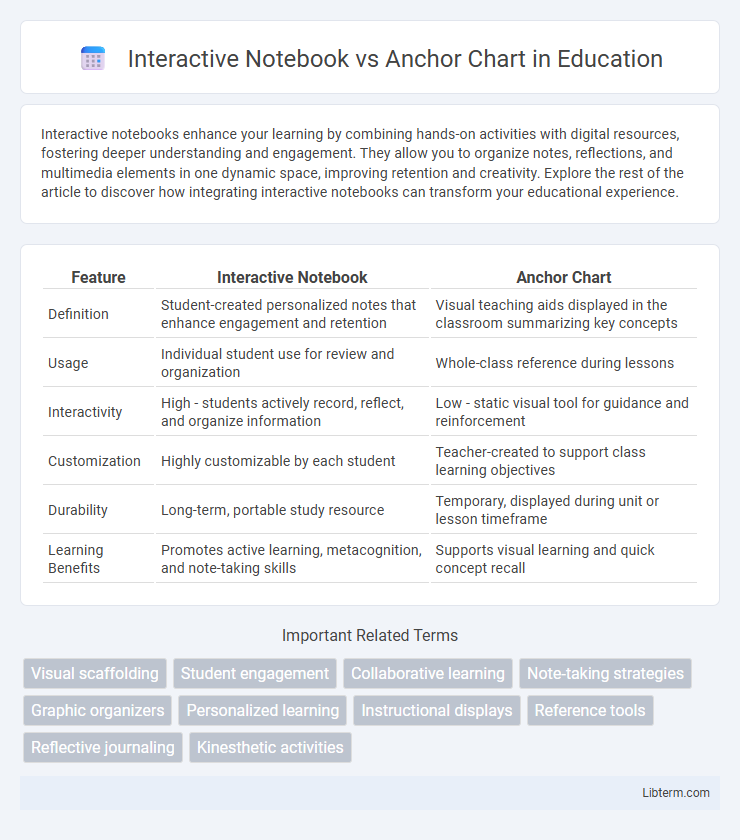Interactive notebooks enhance your learning by combining hands-on activities with digital resources, fostering deeper understanding and engagement. They allow you to organize notes, reflections, and multimedia elements in one dynamic space, improving retention and creativity. Explore the rest of the article to discover how integrating interactive notebooks can transform your educational experience.
Table of Comparison
| Feature | Interactive Notebook | Anchor Chart |
|---|---|---|
| Definition | Student-created personalized notes that enhance engagement and retention | Visual teaching aids displayed in the classroom summarizing key concepts |
| Usage | Individual student use for review and organization | Whole-class reference during lessons |
| Interactivity | High - students actively record, reflect, and organize information | Low - static visual tool for guidance and reinforcement |
| Customization | Highly customizable by each student | Teacher-created to support class learning objectives |
| Durability | Long-term, portable study resource | Temporary, displayed during unit or lesson timeframe |
| Learning Benefits | Promotes active learning, metacognition, and note-taking skills | Supports visual learning and quick concept recall |
Understanding Interactive Notebooks
Interactive notebooks serve as personalized learning tools that actively engage students in organizing and reflecting on course content through hands-on activities, note-taking, and creative expression. Unlike anchor charts, which provide static, visual reference points created by the teacher to summarize essential concepts, interactive notebooks promote deeper understanding by encouraging students to synthesize information and track their learning progress over time. These notebooks enhance cognitive retention and critical thinking by allowing learners to customize entries with diagrams, written reflections, and graphic organizers aligned with curriculum standards.
What Are Anchor Charts?
Anchor charts are visual tools used in classrooms to support student learning by displaying key concepts, strategies, and processes in a clear and organized manner. They serve as reference points for students, helping to reinforce lessons and enable better retention of information. Unlike interactive notebooks, which are personal and tactile learning tools, anchor charts are typically large, collaboratively created, and displayed prominently to engage the entire class.
Key Features of Interactive Notebooks
Interactive Notebooks feature personalized, hands-on learning through students' note-taking, reflection, and creative responses, promoting active engagement and better retention. These notebooks integrate various formats such as foldables, graphic organizers, and student-generated content, facilitating individualized learning and ongoing assessment. The dynamic nature of Interactive Notebooks supports organized content review and differentiated instruction, contrasting with the static display function of Anchor Charts.
Main Characteristics of Anchor Charts
Anchor charts serve as visual tools that capture key concepts, strategies, and processes during lessons to reinforce student understanding and engagement. They are typically displayed prominently in the classroom for ongoing reference, featuring clear, concise language paired with images or symbols to support memory retention. These charts emphasize collaborative creation, often involving student input, which helps personalize learning and solidify grasp of essential content.
Benefits of Using Interactive Notebooks
Interactive notebooks enhance student engagement by promoting active participation and personalized learning through hands-on note-taking and reflection. They provide a dynamic way to organize information, which improves retention and comprehension compared to static anchor charts. Interactive notebooks also allow for continuous assessment and student creativity, fostering deeper understanding and critical thinking skills.
Advantages of Anchor Charts in the Classroom
Anchor charts enhance student engagement by providing a visual reference that reinforces learning and supports diverse learning styles. They promote collaboration and critical thinking as students contribute ideas and concepts during the chart creation process. Durable and easily accessible, anchor charts serve as ongoing tools for review, helping to improve content retention and classroom organization.
Comparing Student Engagement: Notebooks vs Anchor Charts
Interactive notebooks foster individualized student engagement by allowing personalized note-taking, reflections, and hands-on activities that adapt to each learner's pace. Anchor charts create a visually engaging, collaborative classroom environment where students collectively contribute and reference key concepts, promoting group interaction and shared understanding. Both tools enhance engagement uniquely: notebooks promote deep, personal connection with content, while anchor charts support communal learning and quick access to core ideas.
Practical Classroom Applications
Interactive notebooks promote student engagement by allowing personalized note-taking, reflection, and ongoing content organization, enhancing retention and understanding across subjects. Anchor charts provide visual references that summarize key concepts, strategies, or procedures, supporting diverse learners by reinforcing instruction during lessons. Combining both tools optimizes classroom management and differentiated instruction, fostering active participation and accessible review materials.
Tips for Choosing the Right Tool
Selecting the right educational tool depends on the learning objectives and student engagement style; interactive notebooks promote hands-on involvement and personalized note-taking, while anchor charts provide visual references for classroom routines and key concepts. Consider factors like the complexity of content, classroom space, and frequency of use to determine whether a tactile, individualized approach or a clear, collective display best supports student understanding. Integrating assessment goals with classroom dynamics helps educators choose between interactive notebooks and anchor charts effectively.
Integrating Both for Maximum Impact
Integrating interactive notebooks with anchor charts enhances student engagement and retention by combining hands-on learning with visual references. Interactive notebooks allow students to personalize content and reflect on concepts, while anchor charts provide clear, accessible summaries of key ideas to support independent learning. Using both tools together creates a dynamic classroom environment that reinforces understanding and promotes active participation.
Interactive Notebook Infographic

 libterm.com
libterm.com